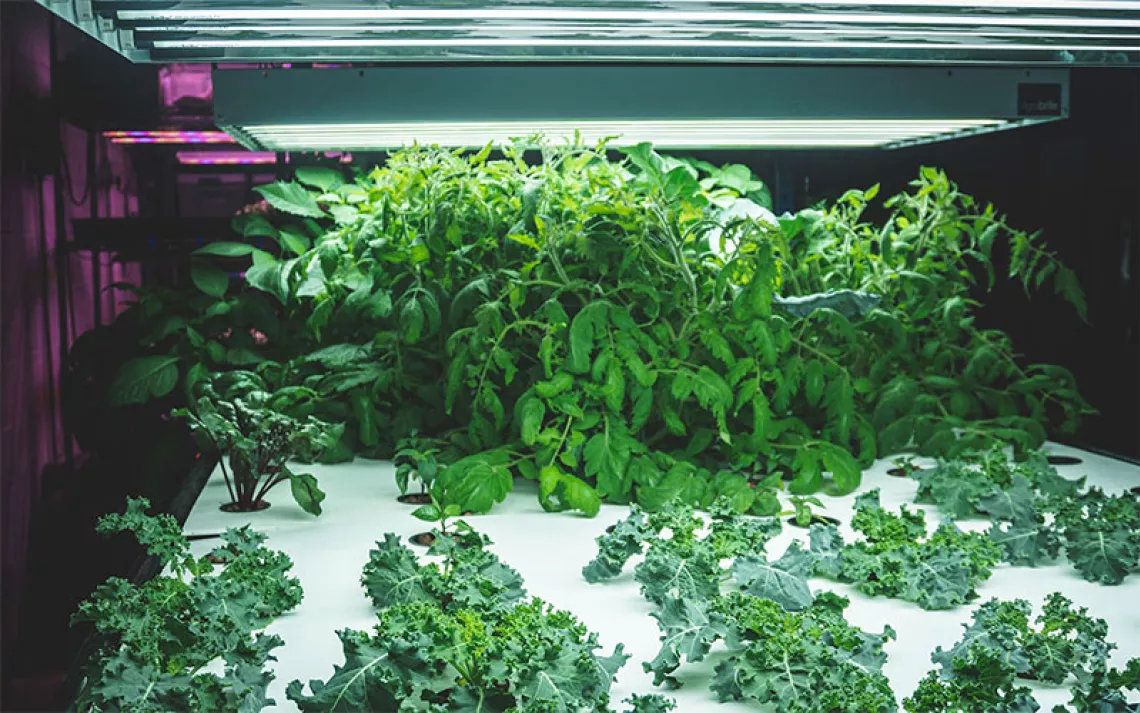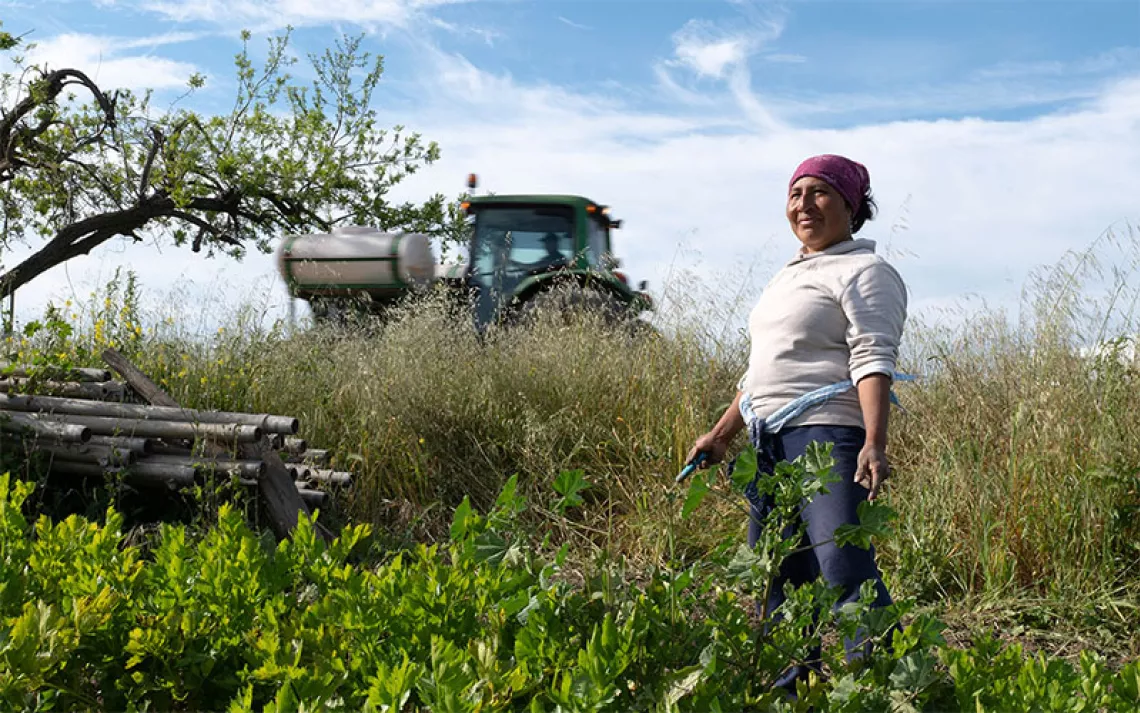Why More Carbon Dioxide May Not Lead to More-Productive Crops
New study challenges what we know about CO2's affect on different plants

Photo courtesy of Big Bluestem: USDA NRCS
Some researchers have argued that there’s a potential upside to climate change: Increases in atmospheric carbon dioxide could be a veritable buffet for plants, they say. One recent study indicated that increases in CO2 concentrations could boost the productivity and water-use efficiency of crops like wheat and rice and even help trees, offsetting some effects of expected increases in temperature and droughts. But a new long-range study published in the journal Science is flipping those slightly rosy predictions on their head—CO2 may not boost crops in the long run and may cause weeds to get even stronger.
Plants, as most of us learn in school early on, absorb carbon dioxide. The CO2 comes in through stomata, or openings in their leaves, then goes through a process called the Calvin cycle, which produces energy from the carbon, sunlight, and water. As part of that process, an enzyme called RuBisCO combines the CO2 and other molecules to form a three-carbon molecule that goes through other changes to form sugars. That metabolic pathway is called C3.
About 32 million years ago, however, CO2 levels in Earth’s atmosphere began dropping. That became a problem for C3 plants, since their RuBisCO enzymes sometimes accidentally grabbed onto the increasingly plentiful and similarly shaped oxygen molecules floating around. That has reduced the efficiency of C3 plants and at higher temperatures can reduce photosynthesis by 25 percent. In response, some species began developing a modified metabolic pathway called C4. Instead of just waiting passively for CO2 to float through their stomata, C4 plants pump CO2 molecules to RuBisCO enzymes throughout their cells, making sure the system is operating at maximum efficiency.
The upshot is that while only about 3 percent of the plant species on Earth are C4, they have been super successful and now represent about 24 percent of the biomass on Earth. Grasses, in particular those that dominate savannas and prairies, are C4 and do very well in hot and dry conditions.
When it comes to the increases in CO2 concentrations expected over the coming century, researchers hypothesized that these changes wouldn’t have much effect on C4 plants, which are already maximizing their carbon use. But many models expected C3 plants to grow bigger and faster, with their leaves absorbing more carbon.
In the new study, however, that wasn’t the whole story. Over the course of 20 years, Peter Reich and his colleagues at the University of Minnesota have run an experiment on 88 plots of C3 and C4 grasses. Using a sophisticated rig, they can grow plants naturally outside a greenhouse yet keep them bathed in a constant bubble of CO2 at 180 parts per million above naturally occurring levels. During the first decade of the experiment—which is actually part of a much larger experiment looking at various types of plants—things went as predicted. The C3 plants, inhaling extra CO2, improved their photosynthesis rates. The C4 plants, which don’t benefit from the extra CO2, were more or less unaffected. But around the 10-year mark, Reich noticed some changes. The C3 response wasn’t quite as strong. The C4 plants, however, were kicking into high gear.

Photo courtesy of UMN Biocon
By the 15th and 20th years of the experiment, the change was unmistakable. The photosynthesis rates of the C4 plants were even stronger than the C3 plants' had been in their most efficient years. And the efficiency of the C3 grasses declined despite still growing in a cloud of CO2. In other words, the hypothesis that C3s would thrive in a world with higher CO2 levels was turned on its head.
Why exactly that switch happened is still under investigation. Reich estimates that 90 percent of the grasses in the experiment are the same ones planted 20 years ago, so the switch isn’t caused by generational differences in the plants. Differences in temperature and rainfall were ruled out. He says the physiology of the plants is still the same, and the C3 and C4 pathways are still working normally.
But there is one measurable difference: In the soil below the C4 plants, available nitrogen increased while under the C3 plants it decreased. Some type of interaction with the CO2 and soil microbes, mycelium, or other factors changed the available nitrogen. Without enough soil nitrogen, the C3 plants simply couldn’t take advantage of the extra carbon dioxide. Increased nitrogen for the C4 plants led to a growth boom.
Reich says that he’s working on a similar study in the eucalyptus forests of Australia, where they are pumping in extra CO2. In the first three years of study, the C3 trees did not seem to respond, likely because they live in soils where phosphorous is in short supply. He points out that other studies have shown the same thing—it doesn’t matter how much CO2 is available to plants if their growth is limited by soil minerals.
“The C3/C4 paradigm is one of the few things that was considered a rock-solid truism in ecology,” Reich says. “Although the fundamental reason for that paradigm still holds, it seems to me that in a mere 20 years the standard interaction between plants and soil communities can change. To me it’s kind of a cautionary tale. We shouldn’t be as confident that we can really understand the trajectory of grasslands or agriculture systems or forests over 10-, 20-, or 40-year time scales. We should be really circumspect in how confident we are in how we think these things are going.”
In an essay accompanying the study, Mark Hovenden of the University of Tasmania and Paul Newton of AgResearch in New Zealand suggest that if Reich’s findings hold for other C3 species and ecosystems, those mildly rosy scenarios of bumper crops driven by climate change won’t materialize. Instead, we may see C3 crop productivity remain flat while weeds and invasive plants, many of which are C4 species, run wild.
Reich, for one, thinks we simply don’t know enough about how ecosystems work to make predictions. Learning more, however, requires similar types of long-term, expensive projects like his that are rare and getting even harder to fund. “It’s clear that ecosystems are complex and there’s lots of things that can change the way they behave, whether it’s the plants in the system, the soil, insects, or other variables. We really spend lots and lots of money building sophisticated models and looking at the genomics of the system without launching experiments that directly test questions about these interactions,” he says. “You can’t come to a holistic understanding of how these systems will change with just a model. You really need to do an experiment which has the potential to give you unexpected surprises.”
“We may find 50 things a year like this if we did experiments in the Amazon and Arctic tundra and the forests of Massachusetts and everywhere else around the world,” Reich says. “We need dozens of these to understand where we’re driving the planet.”
 The Magazine of The Sierra Club
The Magazine of The Sierra Club



